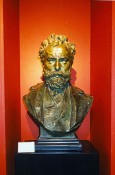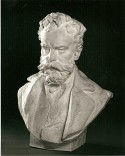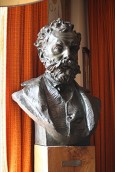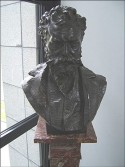The browser will either open the file, download it, or display a dialog.

Auguste Rodin’s Bust of the Belgian Physician Jules-Adrien Thiriar (1846–1913)
Introduction
While most contributions in the “New Discoveries” section deal with works that have recently come to light, this one focuses on a work that has recently disappeared. Auguste Rodin’s terra cotta bust of the Belgian physician Jules Thiriar (fig. 1), possibly the initial version of a work known today only in the form of three bronze casts, was sold by Thiriar’s descendants in the 1920s or 1930s.[1] At some point in time, it made its way to the Galerie Dieleman, which sold the work in the late 1990s, after which its whereabouts have been unknown. The purpose of this article is not only to rescue this terra cotta bust from oblivion, but also to focus attention on the complicated history of the casting of this piece. Indeed, Thiriar’s bust is presented as a case study of the difficulties one may encounter in unraveling the precise histories of different casts of a single piece and their relationship to an original. These difficulties are the greater for the bust of Thiriar, as it is one of Rodin's early works, made at a time when few people, including Rodin himself, could have predicted his future fame.
Rodin and Thiriar
When Rodin first met Jules Thiriar (1846–1913) in Brussels in 1874, Thiriar was a young medical doctor, who had completed his degree only three years earlier. Even as a young surgeon, Thiriar was known for his dexterity, which allowed him to shorten the time of surgical procedures. He also was an admirer of Louis Pasteur in France and of Joseph Lister in Great Britain, under whose combined influence he had started to operate using antiseptics. Very soon, he obtained excellent results. The thesis that he submitted, in 1882, to the Université Libre of Brussels (where he would become a professor three years later) on the antiseptic removal of ovarian cysts, was based on a series of six operations, all successful—an exceptional result at the time. In addition to his surgical prowess, Thiriar was known for his concern with public health. Long considered the doctor of the poor, as chef de service (department head [of surgery]) at the Hôpital St. Pierre in Brussels, he adjusted the prices of his consultations to the financial means of his patients in order to encourage the poorest among them to get proper care.[2]
According to Judith Cladel, Rodin was hurt around 1874 as a result of “excessive efforts to move blocks of stone."[3] Plagued by abdominal pains, he consulted Thiriar who diagnosed a hernia. One account, published in 1889 by the American journalist Truman Th. Bartlett, recites that Thiriar initially planned to push the hernia back, but abandoned the idea for fear of causing an infection.[4] He then decided to operate on Rodin. The operation took place, following some sources, in 1874; following others, in 1872.[5] The medical report reveals that Rodin was operated on sous le spray, a method whereby the surgical field was continuously drizzled with a solution of carbolic lotion, while instruments and bandages were soaked in a solution of carbolic acid.[6] After recovery, the sculptor thanked his surgeon, whose bill he had yet to pay. Recounts Cladel:
He asked him, not without a pang of anxiety, how much he owed him. Noticing hisless than elegant demeanor, the doctor answered:
—Twelve francs.
—Twelve francs? Rodin asked full of amazement. Here you are, but if you want, I’ll make your bust.[7]
The Terra Cotta Bust of Thiriar and its Casts
According to Bartlett, and confirmed by family legend, Jules Thiriar hesitated before he allowed Rodin to make his portrait.[8] Did he have doubts about Rodin’s talent? Regardless, he made inquiries about the reputation of the sculptor before agreeing to a few sittings.[9] The first known version of his bust is a terra cotta, exhibited in 1874 at the 29th triennial exhibition of Ghent (catalog no. 1138; fig. 1).[10] It is difficult to exactly pinpoint the place of this work in the sculptural production process. It could be either the original clay model made from life, probably hollowed out and baked,[11] or a terra cotta cast from a mold made after the original model, which could have been destroyed in the process.
The terra cotta bust exhibited in Ghent was, until 1929, the property of the Thiriar family.[12] Some time after that date it must have been sold to the Galerie Dieleman (Grand-Leez, Belgium), which confirms that it resold the bust in 1997 or 1998. [13] The present whereabouts are unknown.
In 1875, Rodin exhibited a plaster version of the bust of Jules Thiriar at the Salon Triennial of Brussels (cat. no. 1770). [14] It is difficult to explain why, in two successive years, the sculptor presented the same bust in two different materials. Did he consider the work especially successful? Did he feel it was important to reach both the Brussels and the Ghent publics? Was he hoping that a plaster, rather than a terra cotta, could lead to an invitation for a commission? The existence of a plaster cast proves, of course, that a mold of the bust existed at the time. The plaster cast exhibited in Ghent must not be confused with the one preserved in the Musée Rodin (Inv. S.1 455; R15; fig. 2), which was made in 1929 from the terra cotta in the Thiriar family’s collection.[15]
The first known bronze versions of the bust were cast in 1902, using the lost wax method, by the Compagnie des Bronzes in Brussels.[16] We do not know how many casts were produced then, and only two are known with certainty today. One is in the collection of the great-grand nephew of Jules Thiriar, but not through inheritance (fig. 3). Instead it was bought by the grandfather of the current owner some time in the 1950s or 1960s.[17] The other is at the Hirshhorn Museum in Washington, DC.[18] Both are high-quality casts, covered with a matte black patina and were cast from the same mold from which the plaster exhibited in 1875 in Brussels was cast, or, if that mold had been destroyed or had vanished, from a mold made from that plaster cast.
In the catalog of the 1997 exhibition Vers l’Age d’Airain: Rodin en Belgique, the height of the terra cotta is given as 62 cm, i.e., 8 cm taller than the bronze casts, which measures 54.3 cm.[19] This does not necessarily mean that the terra cotta was not used as a model for the mold, as the foundries were able to reduce or enlarge the dimensions.
We don’t know the exact circumstances of the production of the 1902 casts, but it may be related to events in Thiriar’s life. By the turn of the nineteenth century, Thiriar had become a renowned doctor and surgeon, well-known as the personal physician of King Leopold II.[20] If, as the catalog of the 1997 exhibition Vers l’age d’airain suggests, the production of the casts by the Compagnie des Bronzes was requested by Thiriar himself, this request may have been made at the occasion of his election as a member to the Académie Royale de Médecine de Belgique in December 1902.[21] It is not known, however, for what location these two busts were intended.
In 1914, one year after Thiriar’s death, a second casting of his bust was completed by the Fonderie Nationale des Bronzes, founded by Jacques Petermann, a former employee of the Compagnie des Bronzes.[22] This time, the sand casting method was used. The only sand-cast bust known today (Musée de la Médecine d’Erasme, Brussels, fig. 4) has a patina that is dark-brown rather than black, and more glossy than the lost-wax cast of 1902. This bust was commissioned by the Université Libre de Bruxelles[23] and was probably unveiled during a commemorative service held in the auditorium of the Institut de Thérapeutique in Leopold Park in June 1914.[24] The three bronze casts, two lost-wax and one sand, raise the question of their respective closeness to the original model. The existence of an original plaster cast made in 1875 has caused us to assume that the Compagnie des Bronzes, with which Rodin was working at the time, may have had a mold in storage that they could have used for the 1902 casting. Unfortunately, there are no contracts or other archival documents that confirm this. The silence of Rodin’s own archives suggests that the sculptor was not asked for authorization to produce the 1902 casts. The casting of 1914 is even more ambiguous. How could the Fonderie Nationale des Bronzes, the main competitor of the Compagnie des Bronzes, have obtained the mold for the bust and the authorization to use it? It is known that during the first years of the twentieth century, Rodin worked regularly with Petermann,[25] and it is possible that he intervened with the Compagnie des Bronzes. It is also possible, however, that the sandcast bust of 1914 was made from a mold made from the 1902 wax-cast bronze. L’Etoile belge referred to that sandcast bust as a “reproduction,”[26] a term that could confirm the latter possibility.
Reception
It appears that the contemporary press took little notice when Thiriar’s busts (terra cotta and plaster) were exhibited in 1874 (Ghent) and 1875 (Brussels), respectively. Neither in 1874 nor in 1875 do we find mention of Rodin’s busts in L’Art universel, the organ of the Société Libre des Beaux-Arts, despite the fact that this society promoted realist art. Nor is Rodin mentioned in a short article by Camille Lemonnier in L’Art universel on Salon sculpture, published on October 25, 1875.[27] A very positive critique appeared, however, in a review of the Ghent Salon in L’ Echo du Parlement belge on November 20, 1874.[28] The review was written by no less than Jean Rousseau, Directeur Géneral des Beaux-Arts, des Lettres et des Sciences in the Belgian Interior Ministry. To Rousseau, Rodin’s work was “a true masterpiece…. It is not only a beautiful and good sculpture, it is a very original sculpture, quite personal and with an outspoken modern accent, executed with an amazing élan, made with little touches like a painting and suggesting life, thought, and character through each of these touches with rare power.” [29] Rousseau’s description of the work, which alludes to impressionist painting, appears to indicate that he saw Rodin’s sculpture as a modern work par excellence.
Conclusion
Despite Rousseau’s enthusiastic endorsement of Rodin’s bust of Thiriar, the work has not gained an important place in Rodin’s oeuvre. There are several reasons for this. First, it was a portrait, a genre often seen as a secondary, "bread-and-butter" category of art, not on the same artistic level as imaginary compositions. Second, due to the belated casting of the sculpture in bronze, the work was little known until the twentieth century. Third, the bronze casts of the work that we know today, in all likelihood, don’t give an adequate impression of the original terra cotta, which was not initially intended to be cast into bronze. Indeed, to Rodin, terra cotta was a "final" material, which he used to great effect from the late 1870s to the early 1890s to lend spontaneity and realism to his portrait busts, much in the manner of eighteenth-century sculptors like Jean-Antoine Houdon. It is the terra cotta’s immediacy and its frank naturalism that Rousseau referred to when he wrote admiringly of the "amazing élan of execution" and the "modern" character or Rodin’s work. With this in mind, it is to be hoped that the terra cotta bust of Thiriar will soon turn up again, to take its place among Rodin’s other great terra cotta busts of male sitters, such as those of Albert-Ernest Carrier-Belleuse (1882; Musée d’Orsay), and Honoré de Balzac (1891; Metropolitan Museum of Art, New York).
Chloé Pirson
Translated from the French by Petra Chu.
[1] Information kindly given to the author by Michel Thiriar in a conversation on April 13, 2008.
[2] For biographical information about Jules Thiriar, see Pierre Remacle and Jacques-Henri Lefebvre, "Jules Thiriar, 1846–1913," Les Cahiers Louviérois, 3 (1996): 2–27.
[3] Judith Cladel, "La jeunesse de Rodin,"La Revue universelle 59, no. 15 (1934): 418.
[4] Truman T. Bartlett, “August Rodin, Sculptor,” The American Architect and Building News 25, no. 685 (1889): 65–66.
[5] For the 1872 date see Remacle and Lefebvre, "Jules Thiriar, 1864–1913," 9; and Antoinette Le Normand-Romain, Claude Judrin, and Isabelle Vassalo, Vers l’Age d’Airain, Rodin en Belgique, exh. cat. (Paris, Musée Rodin, 1997), 154; for the 1874 date see V. P., “Nécrologie de Jules Thiriar,” Revue de l’Université libre de Bruxelles 18 (1912–13): 724.
[6] V. P., "Nécrologie de Jules Thiriar," 725.
[7] Cladel, "La jeunesse de Rodin," 418.
[8] Le Normand-Romain, Judrin, and Vassalo, Vers l’Age d’Airain, 154.
[9] Ibid.
[10] The patina, unusual for a terra cotta by Rodin, is unexplained. It may have been applied by someone other than the artist at a later date.
[11] See Bartlett, "August Rodin, Sculptor," 65–66.
[12] Le Normand-Romain, Judrin, and Vassalo, Vers l’Age d’Airain, 153.
[13] Information kindly given by Gallery Dieleman (Letter to the author, October 10, 2008)
[14] This plaster version is not located today.
[15] Le Normand-Romain, Judrin, and Vassalo, Vers l’Age d’Airain, 153.
[16] Ibid., 433.
[17] Information given to the author by Michel Thiriar in a conversation on April 13, 2008.
[18] A photograph of the Hirshhorn Musem's Portrait of Docteur Thiriar (accession no. 77.58) is available at http://hirshhorn.si.edu/visit/collection_object.asp?key=32&subkey=11943.
[19] Le Normand-Romain, Judrin, and Vassalo, Vers l’Age d’Airain, 153.
[20] Remacle and Lefebvre, “Jules Thiriar, 1864–1913,” 12–13.
[21] Ibid., 5.
[22] Le Normand-Romain, Judrin, and Vassalo, Vers l’Age d’Airain, 153.
[23] According to L’Etoile belge of June 1914, which reported that “la reproduction d’un admirable buste de Rodin” was made for the occasion of the memorial service. “Echos,” L’Etoile belge 180, June 29, 1914, 2.
[24] Ibid.
[25] See Antoinette Le Normand-Romain, Rodin et le bronze. Catalogue des œuvres conservées au Musée Rodin, 2 vols. (Paris: Musée Rodin-Réunion des Musées Nationaux, 2007).
[26] “Echos,” 2.
[27] Camille Lemonnier, "Les sculpteurs au Salon," L’Art universel, October 25, 1875, 175–76.
[28] Jean Rousseau, “Salon de Gand,” L’Echo du Parlement belge, November 20, 1874, 4.
[29] "un vrai chef-d’œuvre.… Ce n’est pas seulement de la belle et bonne sculpture, c’est une sculpture très originale, bien personnelle et d’un accent franchement moderne, exécutée avec un entrain étonnant, faite par touches comme une peinture et accusant une rare puissance, à chacune de ces touches, la vie, la pensée, le caractère." Ibid.






